Fashion Barons
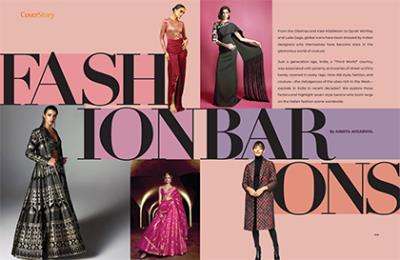
From the Obamas and Kate Middleton to Oprah Winfrey and Lada Gaga, global icons have been dressed by Indian designers who themselves have become stars in the glamorous world of couture.
Just a generation ago, India, a “Third World” country, was associated with poverty and scenes of street urchins barely covered in sooty rags. How did style, fashion, and couture—the indulgences of the uber-rich in the West— explode in India in recent decades? We explore those factors and highlight seven style barons who loom large on the Indian fashion scene worldwide.
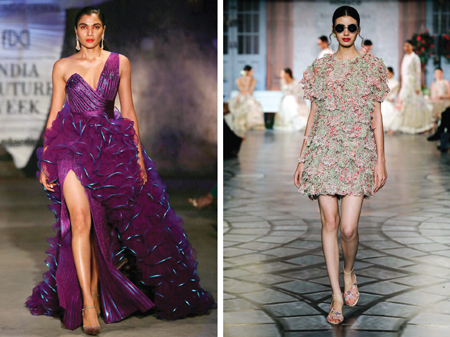
India Couture Week, held biannually by the Fashion Design Council of India (FDCI),
showcases only a handful of the choicest designers. (Photo: fdci.org)
As a young boy growing up in Malhausi, a small village near Kanpur, in Uttar Pradesh, Rahul Mishra was far removed from the world of fashion, both in time and place. Today Mishra holds the distinction of being the first Indian designer to be invited to showcase his work at the elite Chambre Syndicale de la Haute Couture, Paris. He is also the winner of the International Woolmark Prize at Milan Fashion Week. The late Franca Sozzani, editor-in-chief of Vogue Italia, had commended Mishra for “successfully highlighting the best and most peculiar features of his homeland.” Fashion critic and former international fashion editor of Vogue, Suzy Menkes, went further, calling Mishra a “national treasure.”
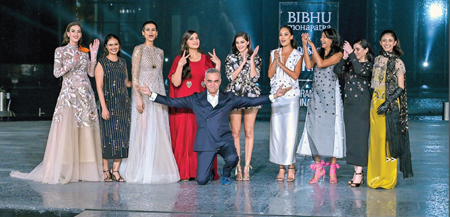
Designer Bibhu Mohapatra with the models at the Lakme Fashion Week. (Photo: Courtesy of Bibhu.com)
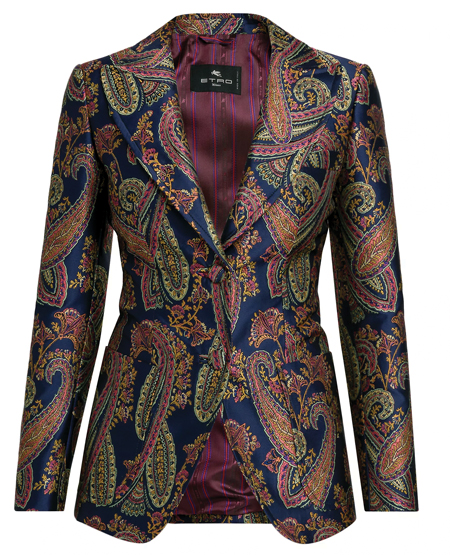 Bibhu Mohapatra, another formidable name among a crop of style barons who have climbed to the upper echelons of their field, gained early inspiration from his mother’s saris. “My mom wore beautiful ikats (Sambalpuri print saris) with vibrant, diverse hues. Sights of those beautiful saris are etched in my memory forever,” Mohapatra says. From a humble upbringing in Odisha (formerly Orissa), he ascended to an education at New York’s Fashion Institute of Technology and eventually claimed the kind of gravitas that had him design for former First Lady Michelle Obama.
Bibhu Mohapatra, another formidable name among a crop of style barons who have climbed to the upper echelons of their field, gained early inspiration from his mother’s saris. “My mom wore beautiful ikats (Sambalpuri print saris) with vibrant, diverse hues. Sights of those beautiful saris are etched in my memory forever,” Mohapatra says. From a humble upbringing in Odisha (formerly Orissa), he ascended to an education at New York’s Fashion Institute of Technology and eventually claimed the kind of gravitas that had him design for former First Lady Michelle Obama.
[Right] A stylish satin jacket at Saks Fifth Avenue featuring the age-old paisley design with its characteristic mango motif.
The rise of Mishra and Mohapatra, along with many of their compatriots, as stars and influencers in fashion is emblematic of India's surge in the glamorous world of couture. It is a story of underdogs who grew up far removed from the catwalks of Paris, Rome, and London, the epicenters of haute couture. Yet, these underdogs are now trendsetters. In an industry hitherto dominated by the West, Indian designers are starting to make their presence felt. “I don’t think there is something called Indian dressing anymore, I dress a universal customer— she may be in Paris, Spain or the U.S.,” Mishra says.
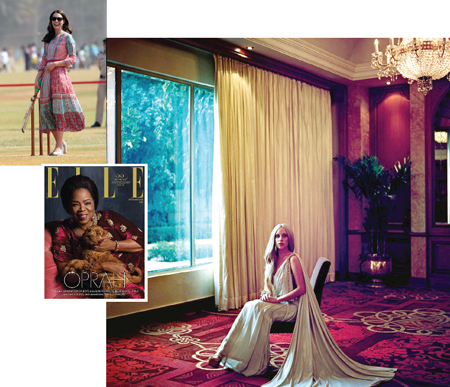
[Top Left] Kate Middleton, Princess of Wales, sporting a breezy summer dress designed by Anita Dongre. (Photo: Courtesy Anita Dongre).
[Inset Middle] Oprah Winfrey in a velvet kaftan by Sabyasachi—on the cover of Elle India.
[Top] Lady Gaga, draped in a sari by Tarun Tahailiani. (Photo: Courtesy of Tarun Tahiliani)
Iconic Western brands are also increasingly sporting Indian art and aesthetics, not to mention Indian craftsmanship. When the age-old paisley design, with its characteristic mango motif, becomes somewhat of a cliché in clothing and starts appearing on everything from shawls at Target to stylish satin jackets at Saks Fifth Avenue, one knows Indian design has gone global.
India was once merely a sourcing hub for big-ticket labels like Zuhair Murad, Elie Saab, and Christian Dior. Now Indian mavericks are brands to reckon with in their own right. Not only are they making waves as fashion gurus but also as industry trendsetters. “I founded my design house on the philosophy of the 3 E’s: Environment, Employment, and Empowerment. This helps us look at luxury from the lens of participation and not just consumption,” Mishra says. Elaborating further, he adds, “The brand’s purpose defines the process. The achingly sloweddown process of hand-weaving and hand embroidery allows us to build sustainable livelihoods for more than a thousand artisans.”
It is in bridging this gap between the haves (the consumers of haute couture) and the have-nots (the artisans, usually rural or indigenous day workers who create these stylish pieces) that Indian designers are perhaps most influential. It is a marriage on other fronts as well: the ancient with the cutting-edge contemporary, the rural traditions of handicrafts with the urban chic. Designer Anita Dongre's “Grassroot,” a sustainable luxury brand, is a direct contribution to the cottage industry, employing artisans from rural India and ensuring that traditional arts like hand weaving and embroidery continue to thrive. Sabyasachi Mukherjee, arguably the most celebrated Indian name in the world of fashion, often collaborates with artisans across India, helping to keep alive age-old crafts like hand embroidery, block printing, and weaving.
The seven fashion barons highlighted in this article are just a small sampling of how Indians are storming the world of fashion. “Indian designers have become a force to reckon with as they have swiftly made a place for themselves as universal style gurus,” says Sunil Sethi, chairman of the Fashion Design Council of India, a body of designers created to uplift the industry. India Couture Week, held biannually by the Council, showcases only a handful of the choicest designers. Quite a few of the exclusive, labor- intensive ensembles on display at this event come with a price tag of upwards of $16,000.
Many in the West who have associated India with poverty may scratch their heads at its ascent in the opulent world of couture. They may be forgetting that this was the land of Maharajas known to have been bejeweled and bedecked from head to toe with the finest of silks and the rarest of precious metals and gems. That said, there are peggable contemporary reasons for India’s rising stock in the world of fashion. A confluence of factors has made it possible: the liberalization of the market in the ’90s, a centuries-old heritage of arts and crafts backed by a long-standing tradition of cottage industry, the rapid growth of a global Indian diaspora, and the expansion of the middle class with disposable income and global aspirations.
The opening up of the markets in the ’90s unleashed a “perfect storm” of events in favor of the fashion industry and consumerism in general. A rapidly growing middle class, with multiple earners living under the same roof, found itself itching to spend their disposable incomes. Meanwhile, globalization and the advent of the Internet exposed an increasingly brand-conscious generation to Gucci, Rolex, and a plethora of other big names and style trends.
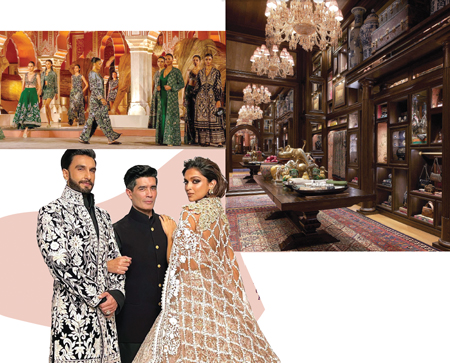
[Top Left] Models at Anita Dongre’s Rewild’24, a craft-led couture show.
[Above] Sabyasachi’s opulent store in New York City is in The Archive building, which is listed in the National Register of Landmarked Buildings.
[Left] Manish Malhotra (center) with Bollywood heartthrobs Deepika Padukone and Ranveer Singh. (Photo: Courtesy Manish Malhotra)
This exposure influenced Indian designers who started incorporating international styles and sensibilities into their designs, leading to a more cosmopolitan and diverse Indian fashion scene. Organized fashion events like the Lakme Fashion Week and the Amazon India Fashion Week started in this era. These platforms were instrumental in bringing Indian fashion to the forefront, offering designers a stage to showcase their work to national and international buyers and media. Meanwhile, the proliferation of shopping malls and branded retail outlets provided a voluminous national market for Indian designers.
As a result of all this, the Indian textile and apparel market reached $172 billion in 2022, according to the International Market Analysis Research and Consulting Services (IMARC) Group. It predicts that the market will explode to $387 billion by 2028. A Bain and Company report indicates that India’s luxury market will grow to 3.5 times its size and reach the $200 billion mark by 2030. The wedding market alone is worth $40 billion.
The Indian market is no longer restricted to just domestic consumption as it is now wooing a large and interested global audience. The NRI population, especially in countries like the U.S., England, and the UAE, craves the great Indian wedding with all the bells and whistles. “An NRI bride in Philadelphia knows as much about what she wants and from whom as much as the one in Raipur, thanks to IG and various other forms of social media. There has been a democratization in fashion and couture,” Sethi says.
According to a 2023 Business of Fashion report, the U.S. and the Middle East are priority targets for Indian brands, which are enthusiastically opening stores there. Dongre, Sabyasachi, and Mohapatra now have showrooms in New York City. “The handcrafted traditions of India really need a global platform, and New York is the best place to start,” Dongre told The New York Times.
Not bad for a Mumbai girl whose mother used to stitch clothes for her and five of her siblings. Many, if not most, of the blazing fashion barons of India come from humble roots. They were not born with the proverbial sequined spoon, but they managed to carve an embroidered niche for themselves in the glamorous but fickle world of fashion.
A former editor of L’Officiel India, Asmita Agarwal is a veteran fashion journalist based in New Delhi.
Meet the Style Barons
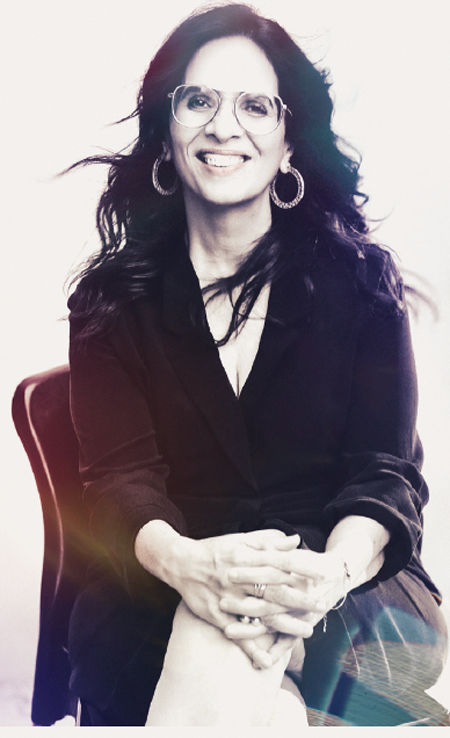 ANITA DONGRE: The queen of sustainable and socially conscious fashion
ANITA DONGRE: The queen of sustainable and socially conscious fashion
In 1995, Dongre launched her first brand from the balcony of her apartment with just two sewing machines. Today she employs 2,800 people who handle her four brands: Anita Dongre Couture, Grassroot by Anita Dongre, AND, and Global Desi. The combined revenue of over a thousand of her stores, spread across 114 cities in four countries, is over Rs. 700 crores (close to $84 million)—a testament to her stratospheric success.
Dongre’s empire stands at the intersection of high fashion and sustainability as well as social consciousness. Her environmentally efficient office in Navi Mumbai spreads over 100,000-square feet and is powered by solar panels. None of her brands use leather, and the packaging they use is entirely biodegradable. A vegan and a PETA supporter, she says, “The vegan accessories line is a dream come true. [We offer] leather alternatives that are luxurious and high-quality while being cruelty- free and friendly to the environment. This line is guided by a philosophy of fashion that includes conscious, ethical, and timelessly elegant pieces.” Five percent of proceeds from this line of accessories are donated to the India Animal Fund. Her New York showroom, located at 473 West Broadway, spans over 4,500 square feet and is built largely with sustainable cork and wood. Handwoven chanderi and handspun cotton take you to the beauty of Rajasthan with its imposing arches, jaalis, and alcoves.
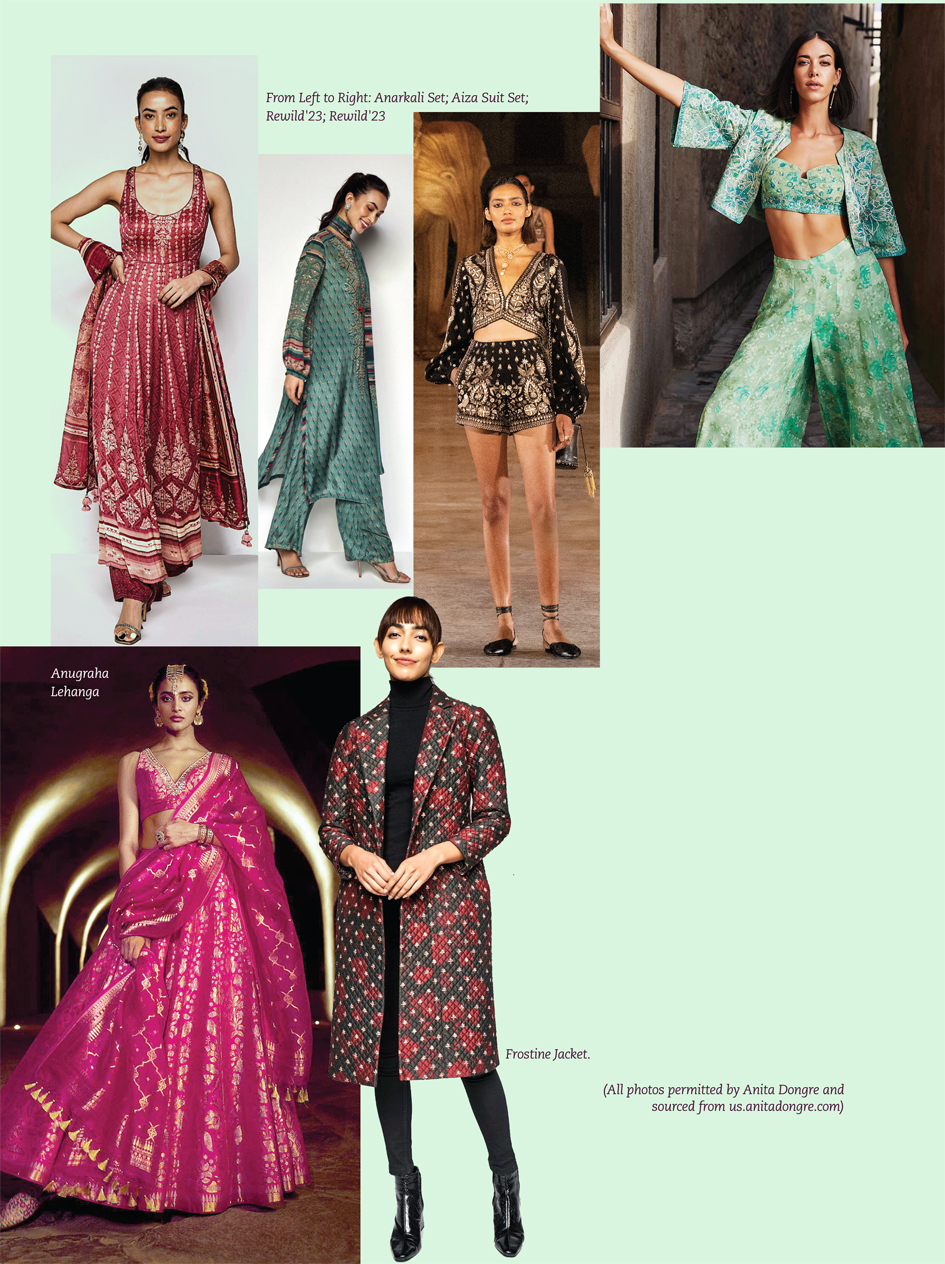
Dongre is also quite socially conscious and engaged. Her Foundation, in collaboration with the Princess Diya Kumari Foundation, organized a fundraiser in October to protect elephants, and the money raised went to the Nature Conservation Foundation.
A sea of Bollywood and international celebrities— Alia Bhatt, Priyanka Chopra, Beyoncé, Kate Middleton, Hillary Clinton, and Queen Mathilde of Belgium, to name a few—are among Dongre’s clients. She is among Forbes India’s list of most powerful businesswomen.
MANISH MALHOTRA: The Bollywood couturier
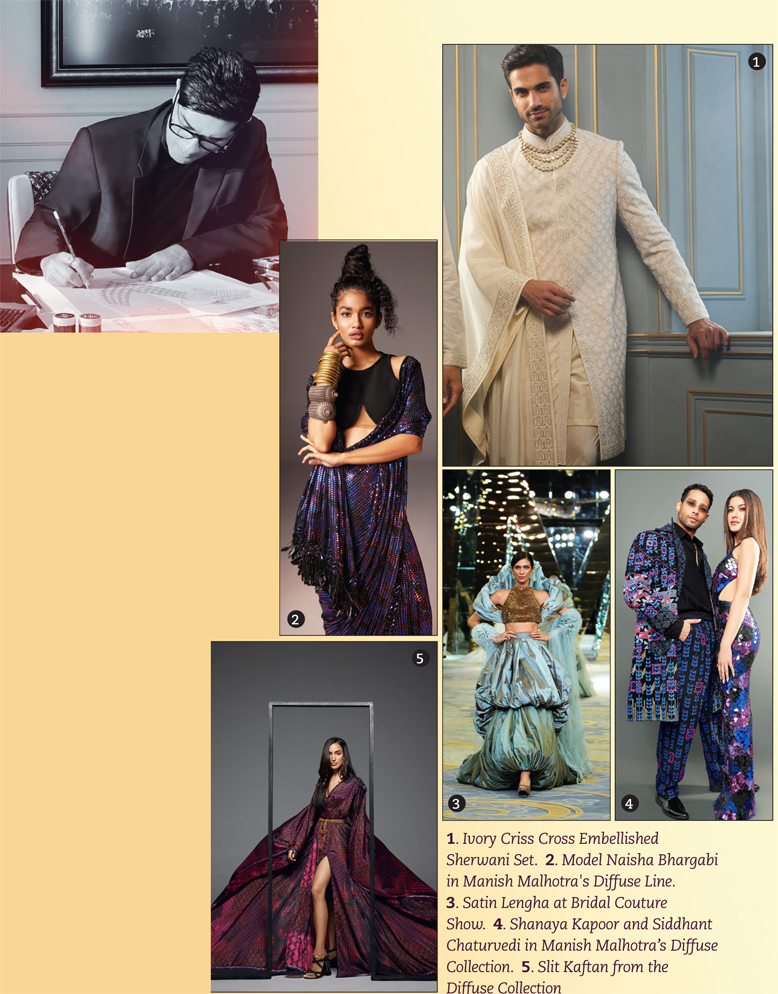 With over three million followers on Instagram, Manish Malhotra is a household name in India. For someone who started out as a model, his journey in the fashion industry is nothing short of a cinematic saga. With a career spanning over three decades, Malhotra has redefined Indian couture, blending the opulence of traditional Indian wear with the dynamism of contemporary fashion. His influence stretches from the glitzy world of Bollywood to the regal realm of bridal couture. Malhotra's designs are a celebration of larger-than-life glamor, winning the hearts of not just Indian cinema's biggest stars but also fashion enthusiasts across the globe.
With over three million followers on Instagram, Manish Malhotra is a household name in India. For someone who started out as a model, his journey in the fashion industry is nothing short of a cinematic saga. With a career spanning over three decades, Malhotra has redefined Indian couture, blending the opulence of traditional Indian wear with the dynamism of contemporary fashion. His influence stretches from the glitzy world of Bollywood to the regal realm of bridal couture. Malhotra's designs are a celebration of larger-than-life glamor, winning the hearts of not just Indian cinema's biggest stars but also fashion enthusiasts across the globe.
Having designed costumes for over a thousand movies, Malhotra is by far the most prolific costume designer in Bollywood, with three Filmfare awards to show for it. His clients often fall in love with his creations made famous by stars. “I want the same color, shape, and trail as the one worn by Bollywood star Parineeti Chopra at her recent wedding”—these are the kinds of requests he commonly gets.
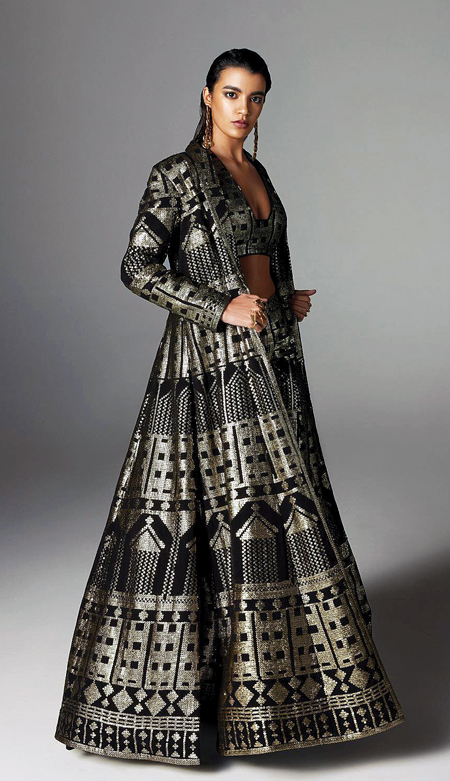 Of his many collaborations in the fashion industry, the one that Malhotra is most proud of is with the Mijwan Welfare Society founded by Urdu poet Kaifi Azmi. Reviving the timeless craft of chikankari embroidery as well as empowering local women engaged in this Lucknowi textile style—two of the main goals of Mijwan—are close to Malhotra’s heart.
Of his many collaborations in the fashion industry, the one that Malhotra is most proud of is with the Mijwan Welfare Society founded by Urdu poet Kaifi Azmi. Reviving the timeless craft of chikankari embroidery as well as empowering local women engaged in this Lucknowi textile style—two of the main goals of Mijwan—are close to Malhotra’s heart.
Malhotra has been in the news lately for designing the uniforms of the entire cabin and cockpit crew of Air India, in its move towards a major rebranding. The new look has gotten rave reviews not only for style but also for comfort. Case in point is a much-lauded saree pantsuit for the female cabin personnel.
Malhotra’s fashion has transcended borders. He was named the creative director of Paco Rabanne, a Parisian label—a first for any Indian. He has been invited to showcase his collection at the Philadelphia Museum of Art and was a speaker at the India Conference at the Harvard Business School as well as the New York University. With many overseas clients, including Reese Witherspoon (in Mira Nair’s Vanity Fair), Hillary Clinton, and supermodels Kate Moss and Naomi Campbell, Malhotra is a global fashion icon.
[Left] Model Karol Massud in Metallics from the Diffuse Collection
(All photos permitted by Manish Malhotra and sourced from https://manishmalhotra.in/)
RAHUL MISHRA: “A national treasure”
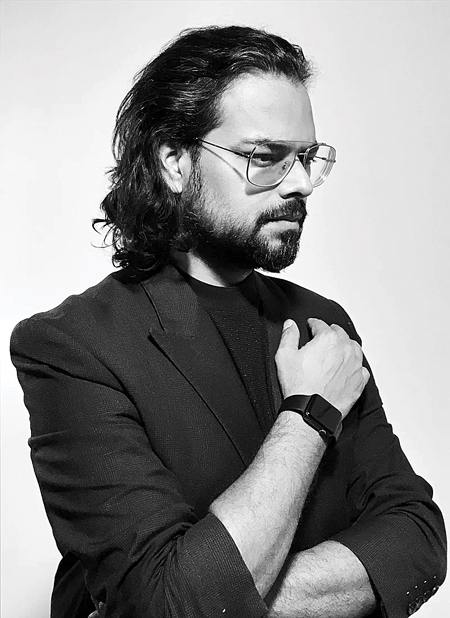
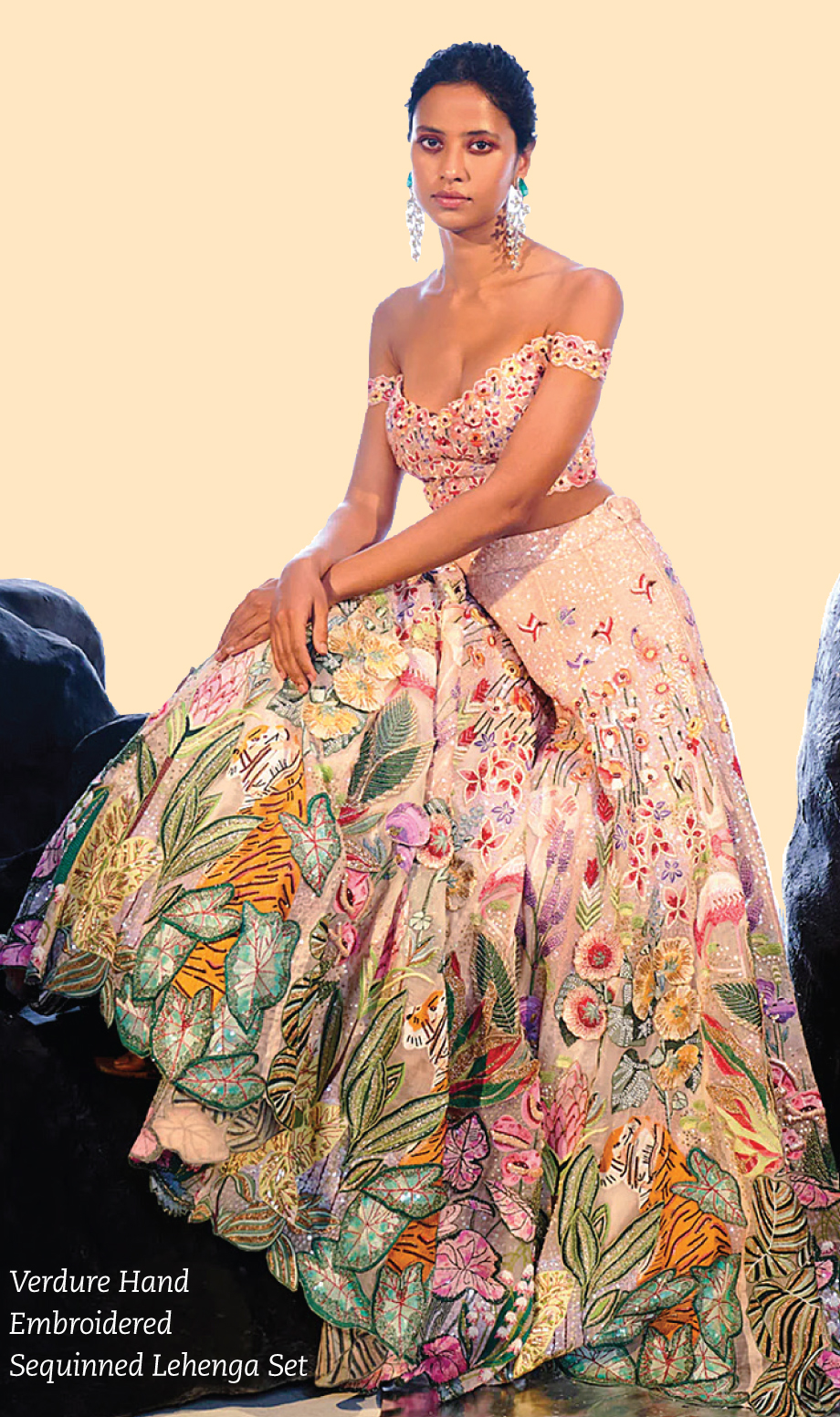 Rahul Mishra holds the distinction of being the first Indian designer to be invited to showcase his work at the elite Chambre Syndicale de la Haute Couture, Paris. He is also the winner of the International Woolmark Prize at the Milan Fashion Week. The late Franca Sozzani, editor-inchief of Vogue Italia, had commended Mishra for “successfully highlighting the best and most peculiar features of his homeland.” Fashion critic and former international fashion editor of Vogue, Suzy Menkes, went further, calling Mishra a “national treasure.”
Rahul Mishra holds the distinction of being the first Indian designer to be invited to showcase his work at the elite Chambre Syndicale de la Haute Couture, Paris. He is also the winner of the International Woolmark Prize at the Milan Fashion Week. The late Franca Sozzani, editor-inchief of Vogue Italia, had commended Mishra for “successfully highlighting the best and most peculiar features of his homeland.” Fashion critic and former international fashion editor of Vogue, Suzy Menkes, went further, calling Mishra a “national treasure.”
Mishra grew up in a village and had little exposure to fashion but made it to the coveted National Institute of Design (NID) in Ahmedabad. He then became the first non-European designer to win a scholarship to study at the Istituto Marangoni, a private Italian school of fashion and design in Milan, Lombardy, Northern Italy.
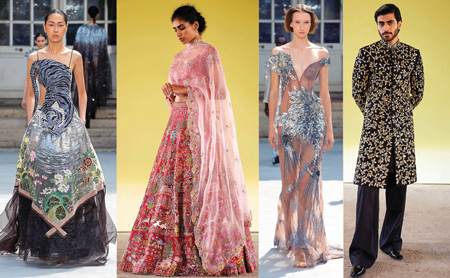
[From Left to Right] Tigress in Sunderbans Gown; Embroidered Navbhumi Lengha Set; Lune Feather Off-
Shoulder Gown; Hand Embroidered Tree of Life Sherwani Set.
Mishra, another leading torchbearer of sustainable fashion, is also a strong proponent of preserving Indian heritage crafts in the service of haute couture. “I founded the design house on the philosophy of the 3 E’s: Environment, Employment, and Empowerment. This helps us look at luxury from the lens of participation and not just consumption,” Mishra says. Elaborating further, he adds, “The brand’s purpose defines the process. The achingly sloweddown process of hand-weaving and hand embroidery allows us to build sustainable livelihoods for more than a thousand artisans.”
(All photos permitted by Rahul Mishra and sourced from https:// rahulmishra.in/)
BIBHU MOHAPATRA: From Odisha to the Big Apple to the White House
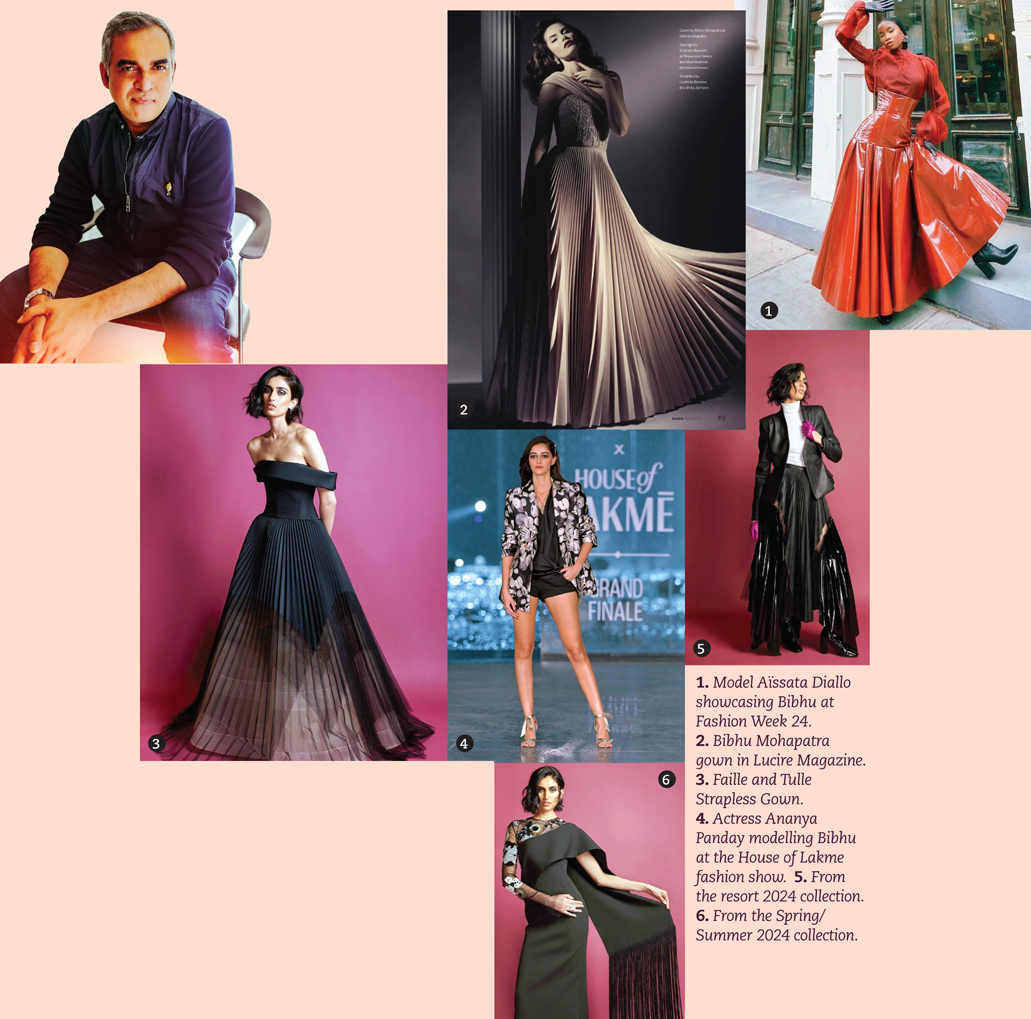 Bibhu Mohapatra's fashion narrative is an intriguing blend of his Odishan roots and the cosmopolitan ethos of New York, where he is currently based. His collections are regularly featured in Vogue and Harper's Bazaar, and he counts amongst his clients Hollywood A-listers like Gwyneth Paltrow and Glenn Close.
Bibhu Mohapatra's fashion narrative is an intriguing blend of his Odishan roots and the cosmopolitan ethos of New York, where he is currently based. His collections are regularly featured in Vogue and Harper's Bazaar, and he counts amongst his clients Hollywood A-listers like Gwyneth Paltrow and Glenn Close.
Known for his luxury women wear and fine jewelry, Mohapatra’s designs stand out for their amalgamation of opposites—traditional and modern, masculine and feminine. His appeal is fashion with global sensibilities but rooted in an Indian touch. Mohapatra’s biggest claim to fame came when he dressed Michelle Obama. The former First Lady had sought him out to dress her for their presidential visit to India. Mohapatra was impressed with Obama’s appreciation of style as well as her acquaintance with Indian heritage textiles like the ikat. “Not only is she intelligent, she also understands style and is a great champion of
the arts,” says he.
Mohapatra’s runaway success did not come easily. While earning a master’s in economics at Utah State University, he worked as a custodian at the University Inn and spent evenings “squeegeeing windows, cleaning toilets, shoveling snow, and vacuuming carpets,” according to Utah State magazine. The moonlighting continued and he survived on one-dollar pizza slices while studying design in New York City. He remembers relentlessly dropping off his resume at the many famed fashion houses in the city.
At the Lakme Fashion Week 2023 in India, the muses for his “Come Home” collection were Ananya Panday, supermodel Lisa Haydon, and actress Bipasha Basu among others who walked the ramp channeling body positivity and inclusivity. “We share a common goal of championing women and celebrating their elegance, strength, and confidence and empowering them to express their unique identities and talents,” said Mohapatra at the event.
(All photos permitted by Bibhu Mohapatra and sourced from Bibhu.com)
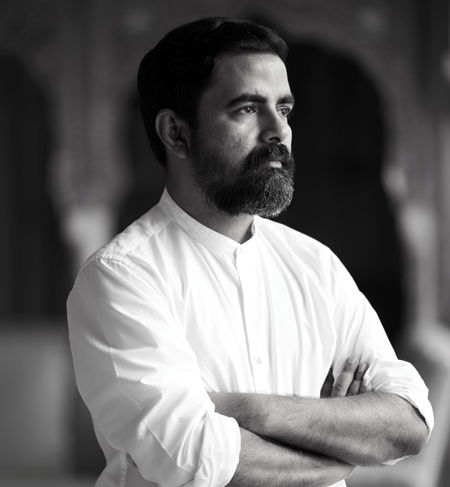 SABYASACHI: The global ambassador of Indian style
SABYASACHI: The global ambassador of Indian style
Sabyasachi Mukherjee’s use of heritage zardozi embroidery and hand-cut sequin designs not only pays homage to Indian artistry but also appeals to a global audience, making him a beloved designer among fashion connoisseurs worldwide. His revival of traditional Indian techniques like block printing and hand-dyeing has garnered global acclaim. He has over 4.5 million Instagram followers, and his collaborations with major brands like Christian Louboutin, H&M, Pottery Barn, Starbucks, L’Oreal, and Disney underscore his international influence.
Meanwhile, domestically, just about all celebrity brides of late have flocked to Sabyasachi to design their wedding dresses: Deepika Padukone, Anushka Sharma, Priyanka Chopra Jonas, and Bipasha Basu to even royalty such as Saba Ali Khan Pataudi. His opulent bridal wear with vintage motifs and an earthy palette has become all the rage. Flaunting a Sabyasachi dress is the ultimate brag in contemporary elite Indian society.
“Opulence” and “grandeur” have become synonymous with Sabyasachi’s creations. This is evident in his New York store housed in The Archive building, which is listed in the National Register of Landmarked Buildings. The 5,800-square-foot store with a 16-foot-high ceiling reminds one of the old palaces of Calcutta, though it is intermingled with antique Dutch pottery, hand-fired tiles from Utah, and cabinets sourced from souks. Leather-bound books, art made by the Sabyasachi Art Foundation, old Indian pichhwais, vintage photography, lithographs as well as handwoven and crafted textiles that boast of India’s golden past make this showroom an attraction in and of itself.
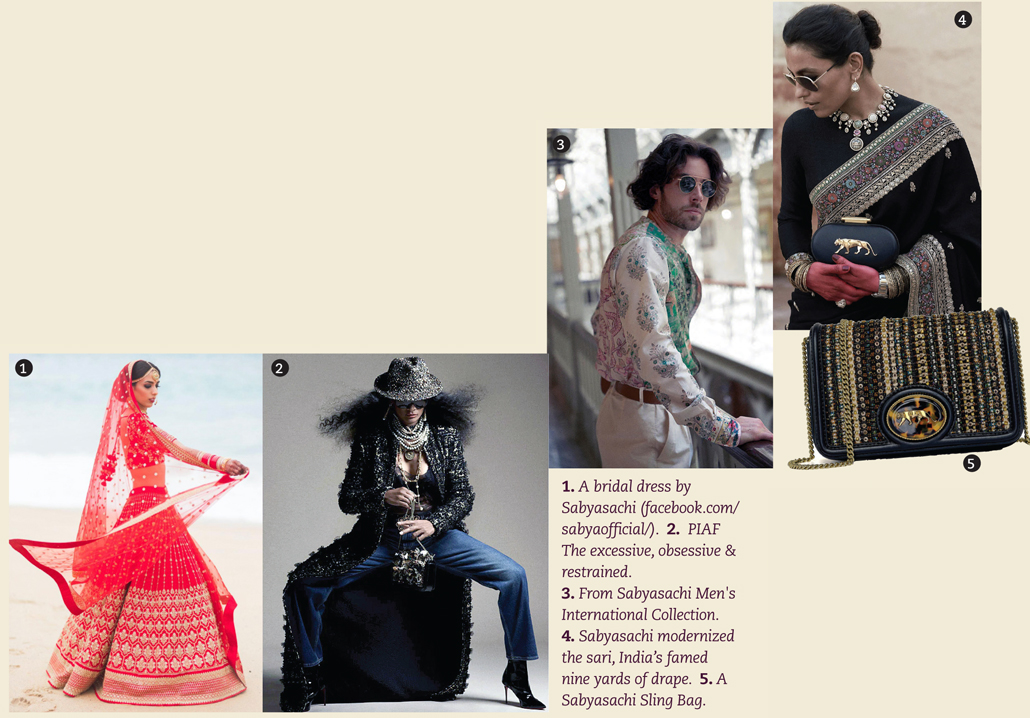
“The more I travel, the more I realize that luxury connoisseurs are part of a unique community. They buy less but they buy the best and the distinctive. Quality, authenticity, and craftsmanship—that’s what they’re looking for,” adds Sabyasachi. Plunking down $9 million and committing to a 15-year lease for his New York store is indicative of his confidence in the U.S. market, which accounts for 30 percent of his business.
While proudly drawing from his native Indian and Bengali influences, Sabyasachi also truly embodies the adage, “The world is my oyster.” His Autumn/Winter 2023 collection features Peruvian alpacas, Mongolian cashmere, Kashmiri pashminas, and the finest English wools intertwined with Japanese cotton and recycled nylons. Italian jacquards from Como, combined with zardozi and artisanal beadwork, create an appeal for the global customer.
(All photos permitted by Sabyasachi and sourced from https://sabyasachi.com/)
SHANTANU & NIKHIL: Edgy fusion that is “zaraa hatt ke”
Brothers Shantanu and Nikhil Mehra have carved a niche in the Indian fashion industry with their distinctive style informed by their “anti-trend” approach. They have redefined bridal wear and couture with an edgy glamor that is a blend of Victorian influences and progressive fusion. Explaining their genderfluid couture philosophy and sartorial choices, they write on their website, “A strong advocate of egalitarianism, the brand believes that both men and women have masculine and feminine energies.”
The pair has given the classical threadwork techniques a new avatar where military detailing merges with vibrant palettes to create dresses advertised as “perfect for special occasions whether in Mumbai or in New York or in Cannes.” The buzz around this duo peaked during the Academy Awards this year when the dashing Ramcharan sported their design for his Oscar nomination for RRR.
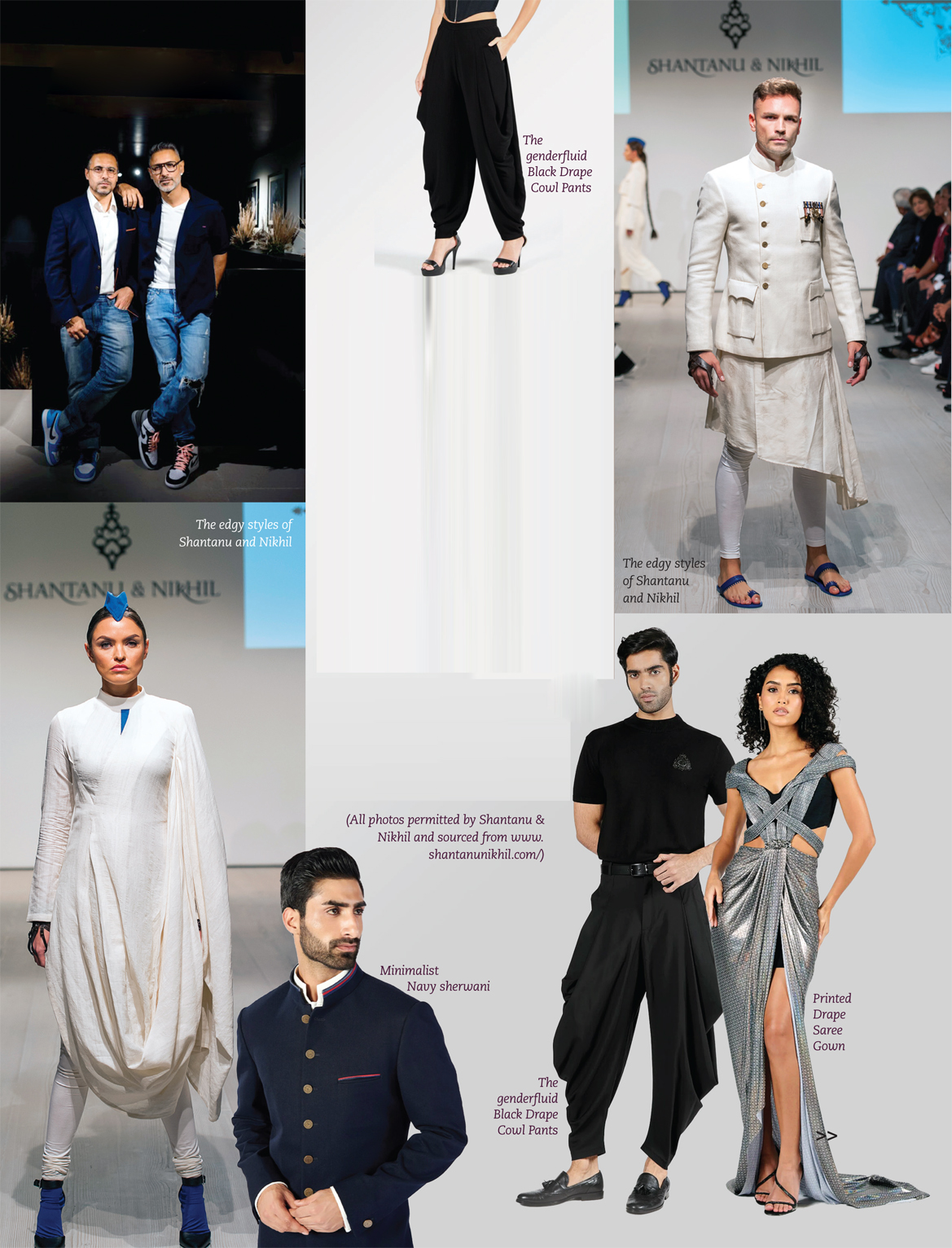
(All photos permitted by Shantanu & Nikhil and sourced from www. shantanunikhil.com/)
TARUN TAHILIANI: Cultural richness and modern elegance
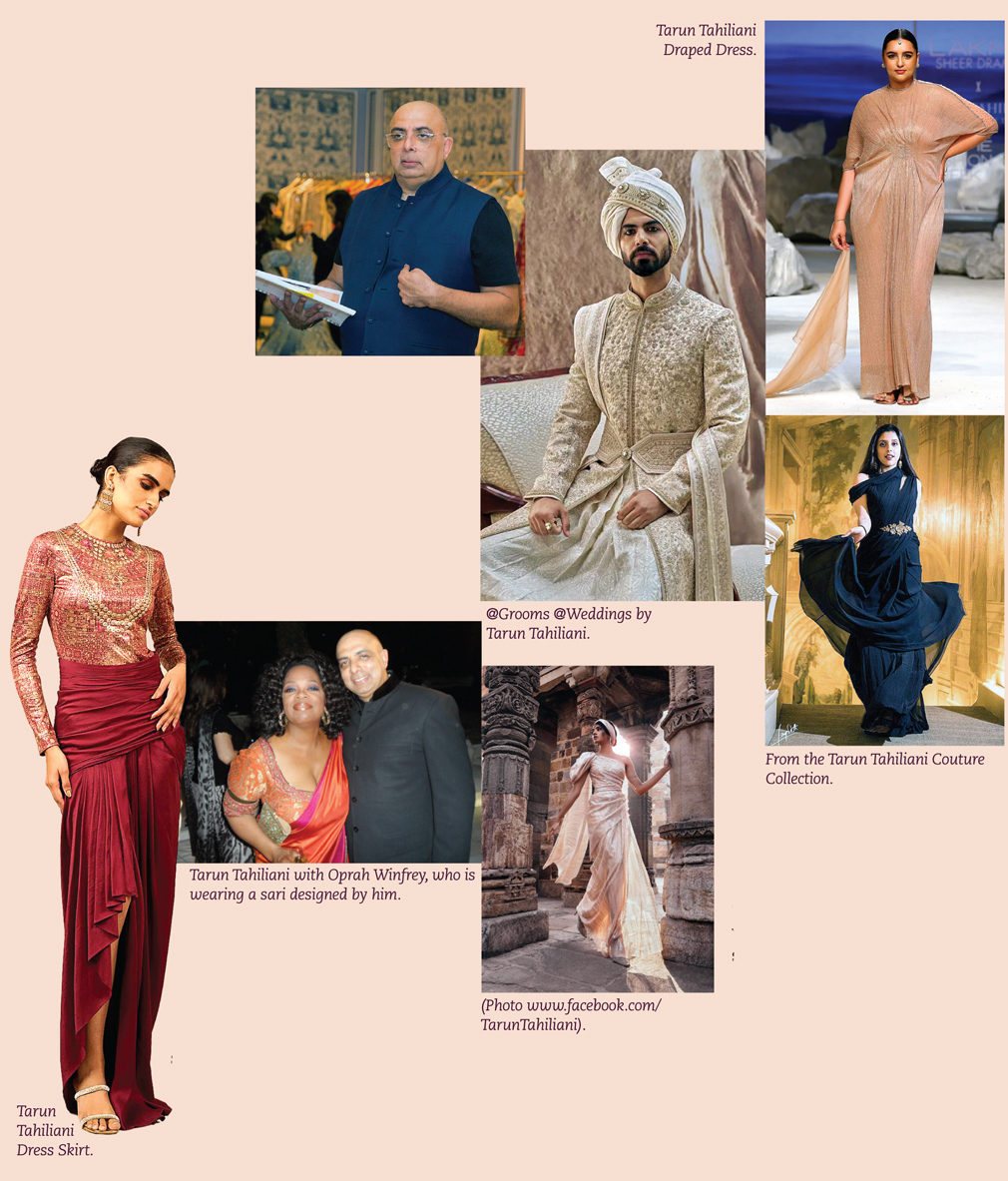
Celebrating his 25th anniversary in the industry, Tahiliani has built a legacy on his ability to innovate while staying true to the Indian aesthetic. He, along with Sabyasachi and a handful of contemporary Indian designers, should get credit for reviving and modernizing the sari, India’s famed nine yards of drape. Tahiliani has been able to lend his magical touch to fabrics like tulle, satin, georgettes, and tussar with his passion for chikankari, Persian motifs, and kashidakaari. Whether it is vivacious print paisleys, kaleens (where traditional carpet designs transformed into wearable art), or gara, his ode to intricate embroidery, Tahiliani pays tribute to exquisite craftsmanship.
Tahiliani was among the handful of founders of the Fashion Design Council of India (FDCI). Always one to push the industry forward, he once stated, "My quest is to fuse our heritage with the technological advances of the contemporary world." He has put the acumen gained from an MBA at Wharton School of Business to good use by addressing a pain point in traditional Indian clothing: comfort, or rather, the lack of it. “Overtly heavy garments that weigh down the wearer are no longer fun. We encourage buyers to wear the finest materials in forms that they can party in while always staying supremely stylish,” says Tahiliani.
In 1994, he held his first solo show at the Dorchester Hotel in London where he was touted as the “Karl Lagerfeld of India” by British fashion editor, Isabella Blow. In September 2003, Tahiliani also became the first Indian designer to showcase at Milan Fashion Week, Luxury prêt. Over the last two decades, his work has traveled to New York, London, Tokyo, Dubai, Singapore, and Karachi.
Bollywood celebrities like Deepika Padukone, Priyanka Chopra, and Shilpa Shetty have often been spotted in his creations. His international clientele includes names like Oprah Winfrey and Lady Gaga.
(All photos permitted by Tarun Tahiliani and sourced from https://shop.taruntahiliani.com/)
Enjoyed reading Khabar magazine? Subscribe to Khabar and get a full digital copy of this Indian-American community magazine.
blog comments powered by Disqus










